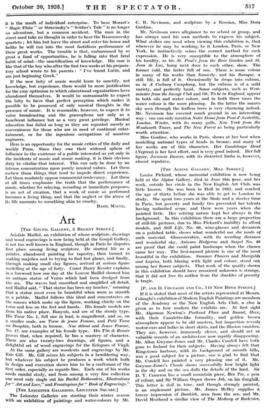[P. AND D. COLNAGRI AND Co., 144 NEW BOND STREET.]
If it is stated that most of the artists represented at Messrs. Colnaghi's exhibition of Modern English Paintings are members of the Academy or the New English Arts Club, a clue is given as to how modern the exhibits are. At first sight Mr. Algernon Newton's Portland Place and Sunset, Hove, with their Canaletto-like formality, and golden brown atmosphere appear to be old masters, but inspection reveals Motor-cars and ladies in short skirts, and the illusion vanishes. They are, however, immensely clever, and should act as valuable records of an architecture now rapidly disappearing. Mr. Allan Gwynne-Jones and Mr. Charles Cundell have both gone to Ireland for their subjects. Having always felt that Kingstown harbour, with its background of smooth hills, was a good subject for a picture, one is glad to find that Mr. Cundell has painted a very pleasing one of it. Mr. Gwynne-Jones's Clouds shows successfully how bright light in the sky and on the sea dulls the details of the land. Sir D. Y. Cameron has a small mountain piece, Ben Tee, a gem Of colour, and Sir William Orpen shows Job, on his dunghill. This latter is dull in tone, and though strongly painted, is an unpleasant picture. Mr. James McBey supplies a breezy impression of Dunkirk, seen from the sea, and Mr. David Muirhead a similar view of The Medway at Rochester. Zelia, a girl with a hat and a curious cloak, painted in rather a formal manner, is much the best of Mr. Gerald Brock-. hurst's three pictures. His larger L'Eventail, with a female figure shown against a portion of a framed picture, seems unbalanced. Mention must also be made of Sir Charles Holmes's Little Waterfall, Miss Codrington's Bramble Blossom, and Miss M. L. Trench's Fonta at Garda. Though not exciting, it is a pleasant show.































































 Previous page
Previous page